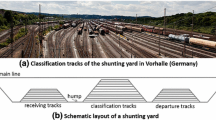Abstract
We address the problem of scheduling work of security guards operating on trains and stations, and explain how operations research is suitable for solving a problem that adds new challenges to classical crew scheduling. Planning the work of these security guards is challenging because it requires dealing not only with the complexity inherent to crew scheduling problems but also with an optimisation goal that itself is defined more in qualitative than quantitative terms. Our contribution to handling these challenges is summarised as follows:
-
we describe the problem and model it as a shortest path problem and a set covering problem with additional constraints;
-
we adapt an existing heuristic that is based on Lagrangian relaxation, subgradient optimisation, column generation and greedy heuristics to be applicable to the problem (for instance, we add an improvement step based on local search);
-
we implement the resulting solution method, resulting in a software prototype named TUTIS;
-
we test TUTIS with a real problem instance supplied by Netherlands Railways.
Experimental results lead security experts to believe that the prototype not only presents meaningful results in terms of scheduling work, but also can help decide the way security guards will be deployed in the future.



Similar content being viewed by others
Notes
Also known in the literature as home depot, the home base is the location in the railway network where the employee starts (finishes) working after (before) a resting period or a day off.
A similar concept is described in Borndörfer et al. (2016), where a profit value varying over time is associated with each motorway section.
Borndörfer et al. (2013) use a similar approach applied to duty templates.
These gaps were obtained in the following way: we ran a problem with the baseline heuristic and with a similar heuristic that uses full enumeration of variables; we then computed the gap by subtracting the upper bound obtained by the baseline heuristic from the lower bound obtained by the full enumeration heuristic (which corresponds to the master problem of the column generation approach).
References
Abbink EW, Albino L, Dollevoet T, Huisman D, Roussado J, Saldanha RL (2011) Solving large scale crew scheduling problems in practice. Public Transp 3(2):149–164
Borndörfer R, Sagnol G, Swarat E (2012) A case study onoptimizing toll enforcements on motorways. In: Ravizza S, Holborn P (eds) Proceedings of the 3rd student conference on operational research. Open acess series in informatics, vol 22, pp 1–10
Borndörfer R, Langenhan A, Löbel A, Schulz C, Weider S (2013) Duty scheduling templates. Public Transp 5(1–2):41–51
Borndörfer R, Sagnol G, Schlechte T, Swarat E (2016) Optimal duty rostering for toll enforcement inspectors. Ann Oper Res pp 1–24
Huisman D (2007) A column generation approach for the rail crew re-scheduling problem. Eur J Oper Res 180(1):163–173
Lau HC, Gunawan A (2012) The patrol scheduling problem, practice and theory of automated timetabling. In: PATAT, pp 175–192
Meerkerk M (2014) Scheduling security and service personnel at Netherlands Railways. Master’s Thesis, Utrecht University
Morgado E, Martins JP (1998) Crews-ns: scheduling train crew in The Netherlands. AI Mag 19(1):25–38
Ordóñez F, Tambe M, Jara JF, Jain M, Kiekintveld C, Tsai J (2013) Handbook of operations research for homeland security. Springer, New York
Pita J, Jain M, Marecki J, Ordóñez F, Portway C, Tambe M, Western C, Paruchuri P, Kraus S (2008) Deployed armor protection: the application of a game theoretic model for security at the los angeles international airport. In: Proceedings of the 7th international conference on autonomous agents and multiagent systems: industrial track, pp 125–132
Pita J, Tambe M, Kiekintveld C, Cullen S, Steigerwald E (2011) Guards: game theoretic security allocation on a national scale. In: Proceedings of the 10th international conference on autonomous agents and multiagent systems, pp 37–44
Potthoff D, Huisman D, Desaulniers G (2010) Column generation with dynamic duty selection for railway crew rescheduling. Transp Sci 44(4):493–505
Shieh E, An B, Yang R, Tambe M, Baldwin C, DiRenzo J, Maule B, Meyer G (2012) Protect: a deployed game theoretic system to protect the ports of the united states. In: Proceedings of the 11th international conference on autonomous agents and multiagent systems, pp 13–20
SISCOG (2016) http://www.siscog.eu
Teamcore (2016) Teamcore research group, University of Southern California. http://teamcore.usc.edu/projects/security
Thorlacius P, Clausen J (2010) Scheduling of inspectors for ticket spot checking in urban rail transportation. In: Trafikdage ved Aalborg Universitet 2008. http://research.create.usc.edu/nonpublishedreports/71
Tsai J, Kiekintveld C, Ordóñez F, Tambe M, Rathi S (2009) Iris—a tool for strategic security allocation in transportation networks.In: Proceedings of the 8th international conference on autonomous agents and multiagent systems (AAMAS 2009)
Yin Z, Jiang AX, Johnson MP, Kiekintveld C, Leyton-Brown K, Sandholm T, Tambe M, Sullivan JP (2012) Trusts: scheduling randomized patrols for fare inspection in transit systems. In: Proceedings of the 24th innovative applications of artificial intelligence conference (IAAI-12), pp 2348–2355
Acknowledgements
We thank all who contributed to this work. Hans Munk initialized the research, provided the data, and gave invaluable insights on the work processes of V&S teams. Luís Albino, Jorge Roussado, Rudi Araújo and Filipa Morgado developed the prototype. Luís and Jorge gave essential contributions on the solution method for job assignment. Finally, we would like to thank Martin van Meerkerk for the dedication he put into working with us on job generation.
Author information
Authors and Affiliations
Corresponding author
Rights and permissions
About this article
Cite this article
Snijders, H., Saldanha, R.L. Decision support for scheduling security crews at Netherlands Railways. Public Transp 9, 193–215 (2017). https://doi.org/10.1007/s12469-016-0142-y
Accepted:
Published:
Issue Date:
DOI: https://doi.org/10.1007/s12469-016-0142-y




